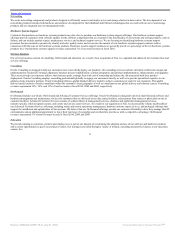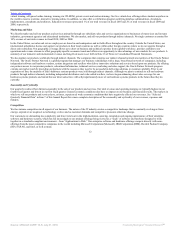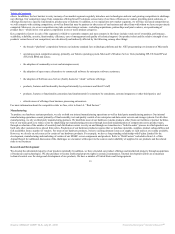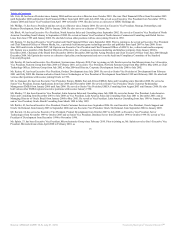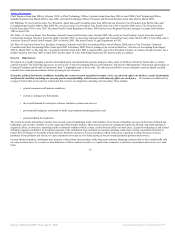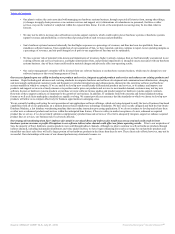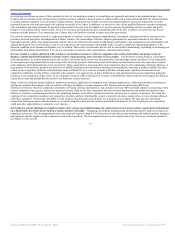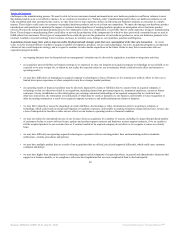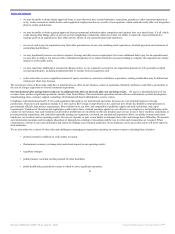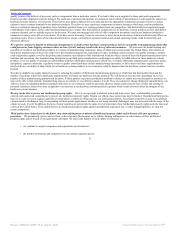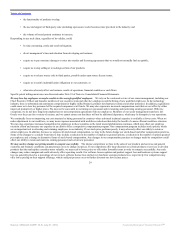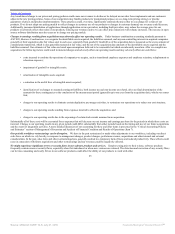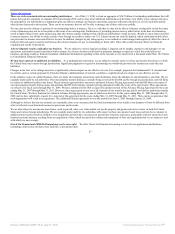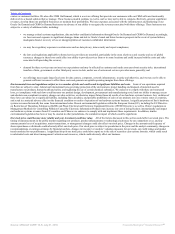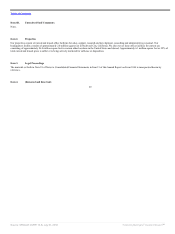Oracle 2009 Annual Report Download - page 25
Download and view the complete annual report
Please find page 25 of the 2009 Oracle annual report below. You can navigate through the pages in the report by either clicking on the pages listed below, or by using the keyword search tool below to find specific information within the annual report.
Table of Contents
• we may be unable to obtain timely approvals from, or may otherwise have certain limitations, restrictions, penalties or other sanctions imposed on
us by, worker councils or similar bodies under applicable employment laws as a result of an acquisition, which could adversely affect our integration
plans in certain jurisdictions;
• we may be unable to obtain required approvals from governmental authorities under competition and antitrust laws on a timely basis, if it all, which
could, among other things, delay or prevent us from completing a transaction, otherwise restrict our ability to realize the expected financial or
strategic goals of an acquisition or have other adverse effects on our current business and operations;
• our use of cash to pay for acquisitions may limit other potential uses of our cash, including stock repurchases, dividend payments and retirement of
outstanding indebtedness;
• we may significantly increase our interest expense, leverage and debt service requirements if we incur additional debt to pay for an acquisition and
we may have to delay or not proceed with a substantial acquisition if we cannot obtain the necessary funding to complete the acquisition in a timely
manner or on favorable terms;
• we may experience additional or unexpected changes in how we are required to account for our acquisitions pursuant to U.S. generally accepted
accounting principles, including arrangements that we assume from an acquisition; and
• to the extent that we issue a significant amount of equity securities in connection with future acquisitions, existing stockholders may be diluted and
earnings per share may decrease.
The occurrence of any of these risks could have a material adverse effect on our business, results of operations, financial condition or cash flows, particularly in
the case of a larger acquisition or several concurrent acquisitions.
Our international sales and operations subject us to additional risks that can adversely affect our operating results. We derive a substantial portion of our
revenues from, and have significant operations, outside of the United States. Our international operations include software and hardware systems development,
manufacturing, sales, customer support, consulting, On Demand and shared administrative service centers.
Compliance with international and U.S. laws and regulations that apply to our international operations increases our cost of doing business in foreign
jurisdictions. These laws and regulations include U.S. laws such as the Foreign Corrupt Practices Act, and local laws which also prohibit corrupt payments to
governmental officials, data privacy requirements, labor relations laws, tax laws, anti-competition regulations, import and trade restrictions, and export
requirements. Violations of these laws and regulations could result in fines, criminal sanctions against us, our officers or our employees, and prohibitions on the
conduct of our business. Any such violations could result in prohibitions on our ability to offer our products and services in one or more countries, could delay or
prevent potential acquisitions, and could also materially damage our reputation, our brand, our international expansion efforts, our ability to attract and retain
employees, our business and our operating results. Our success depends, in part, on our ability to anticipate these risks and manage these difficulties. We monitor
our international operations and investigate allegations of improprieties relating to transactions and the way in which such transactions are recorded. Where
circumstances warrant, we provide information and report our findings to government authorities, but no assurance can be given that action will not be taken by
such authorities.
We are also subject to a variety of other risks and challenges in managing an organization operating in various countries, including those related to:
• general economic conditions in each country or region;
• fluctuations in currency exchange rates and related impacts to our operating results;
• regulatory changes;
• political unrest, terrorism and the potential for other hostilities;
• public health risks, particularly in areas in which we have significant operations;
21
Source: ORACLE CORP, 10-K, July 01, 2010 Powered by Morningstar® Document Research℠


